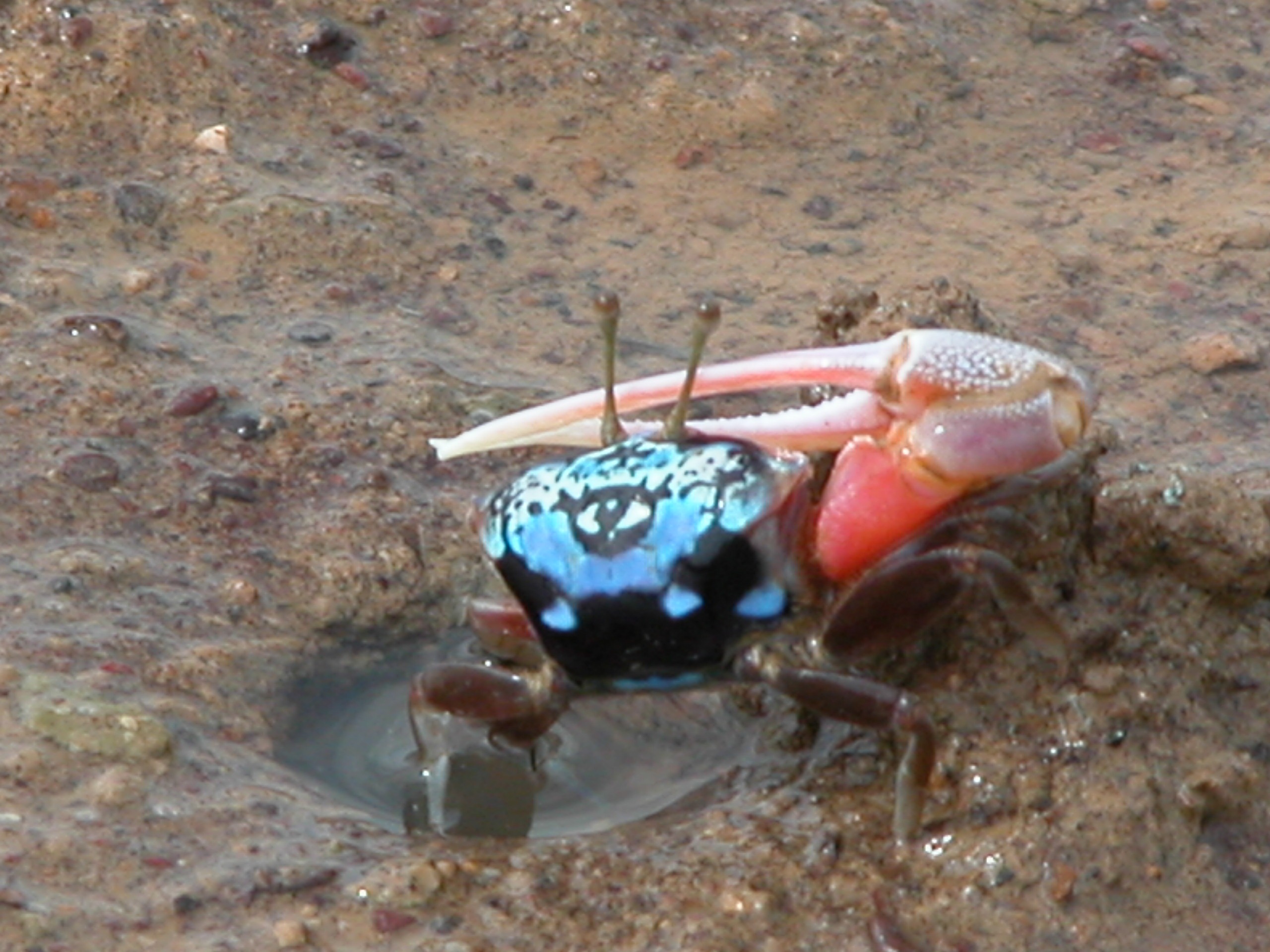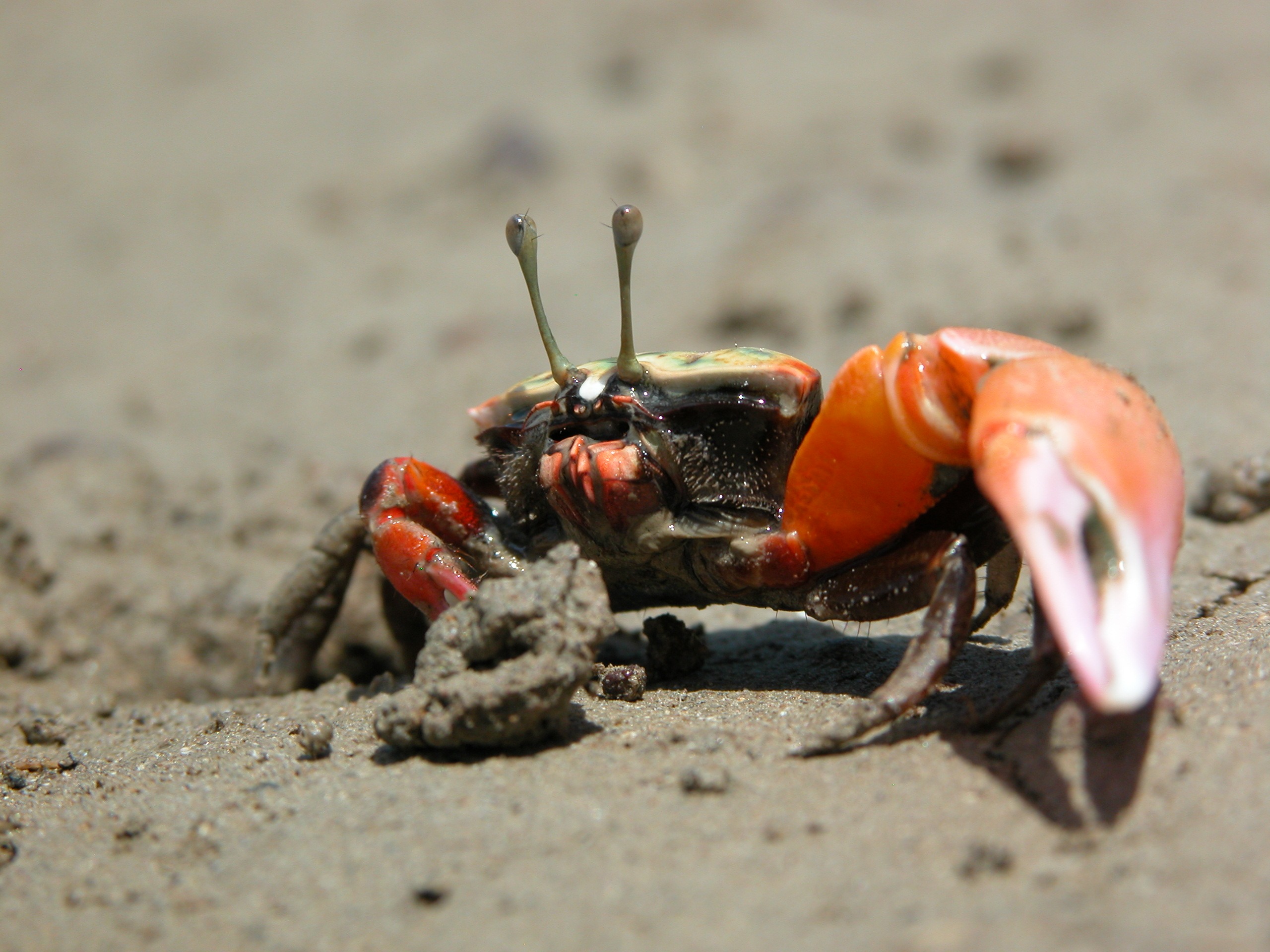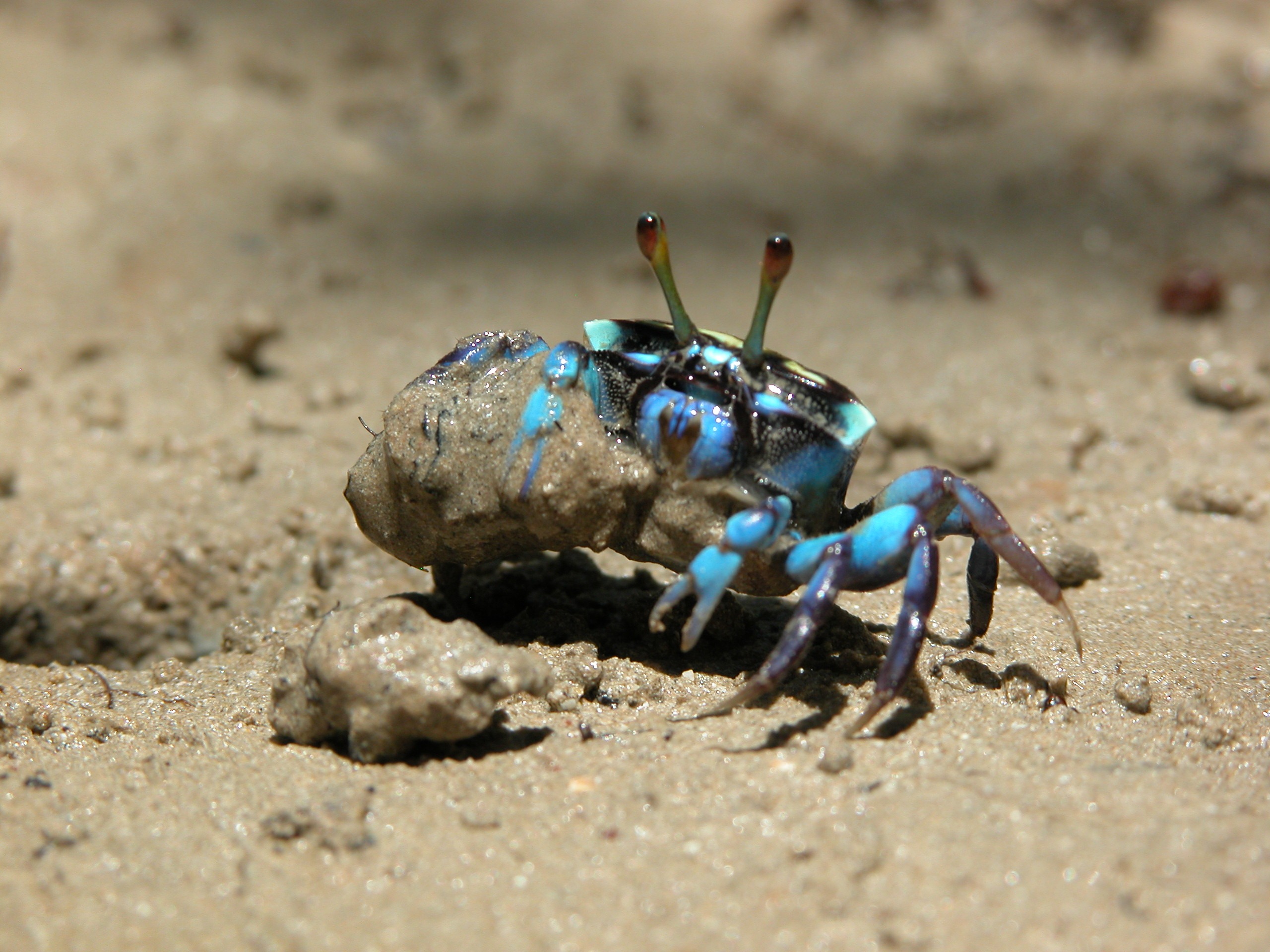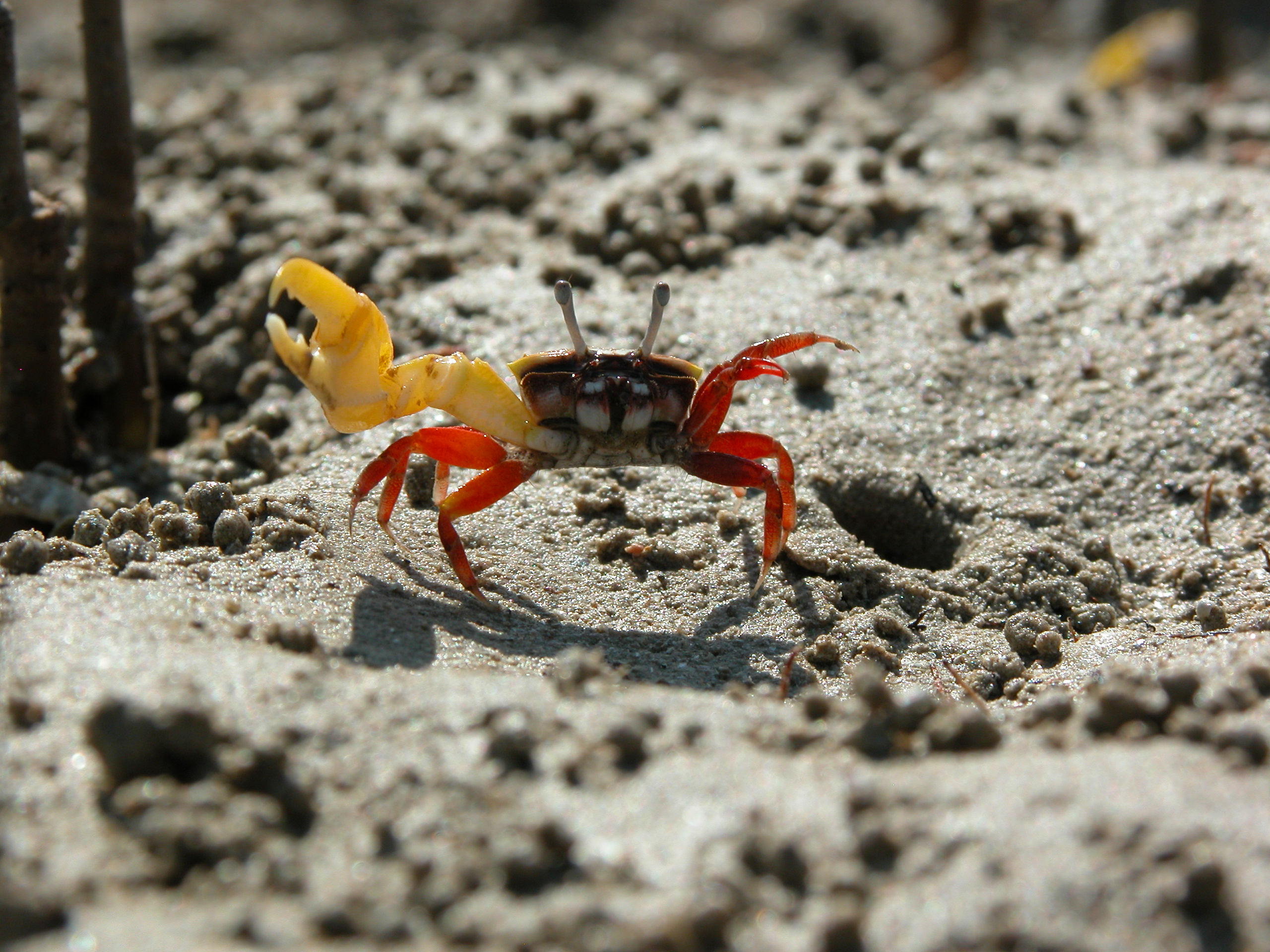FIDDLER CRABS

Fiddler crabs are intertidal animals that
live in mangrove forests, tidal creeks, sandbars, mudflats or,
occasionally, stone or boulder beaches. They can occur in huge numbers,
with thousands of individuals living in small, adjacent territories. Males
and females live intermixed and each individual has its own burrow and a
small area of surface sediment around it. The burrow is extremely
important. It is a refuge during high tide, and during low tide it is a
source of water for keeping the gills wet, it is an escape from predators,
it is the site of mating and incubation. The space
around the burrow is used for feeding and courting.
Males have a single enlarged claw, while females have two
small feeding claws. Fiddlers feed by scraping the surface sediment up in
their small claws, transferring it to the mouth where the complex
mouthparts sift out the organic matter. They then spit out a small pellet
of cleaned sand. These feeling pellets cover the mudflat by the end of the
low tide period. Because males have only one small, feeding claw, they
feed at half the rate of the females. They therefore
have to spend about double the time feeding.
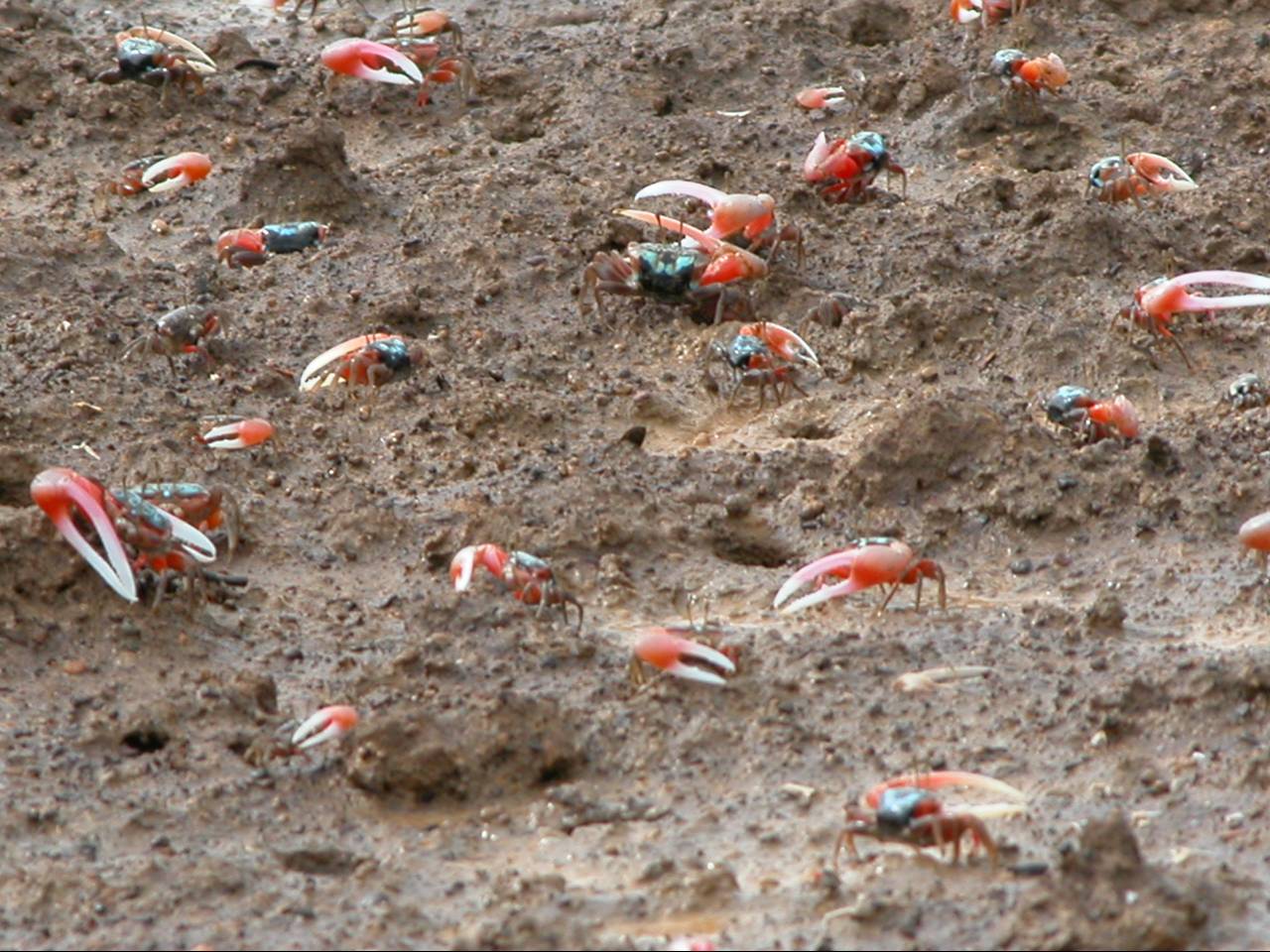
Typical Fiddler crab social system
Males wave their enlarged claw to attract females for mating. When a female is ready to mate (i.e. she has ripe ovaries), she will leave her own burrow and wanders through the population of waving males. She visits several males before selecting a mate (up to 24). A visit consists of a direct approach to the male, he then darts into his burrow, the female follows him in, spends a few seconds underground and then reappears to continue wandering. When the female accepts the male as a mate, she does not reappear, but rather the male emerges about 5 minutes later and gathers up sand to plug the burrow entrance. He plugs it from the inside, sealing him and the female underground. Mating occurs in the terminal chamber of the burrow and the following day, the male emerges. He reseals the burrow entrance with the female underground. The male then leaves the area and wanders around to find an empty burrow or to fight another male for its burrow. The female remains underground for the following two weeks while she incubates her eggs. She does not emerge to feed during this time.
Females time mating so that egg release coincides with a Spring tide. The eggs are released during a nocturnal high spring tide so that the tiny, swimming larvae are washed far out to sea. They develop out there for several weeks and then wash into shore. They settle out of the water column when they detect the odour of adult crabs of their own species. They undergo a final moult to become minute little crabs, and then start their lives on the mudflats.
Fiddlers as a study species
Fiddlers are very active during diurnal low tides. They are constantly busy waving, fighting, mating, feeding or cleaning up around their burrows. Because they occur in such high numbers, data collection is extremely simple. They are easy to watch, either with binoculars or even just by eye. You can catch and mark them with little effort, and they can be ‘caged’ on the mudflat by surrounding them with mesh walls pushed into the sediment. They are the ideal animals for manipulative experimental work.
Females breed every month (two weeks of incubation, two weeks of feeding) and males are ready to mate virtually every day, so you can collect mating data with ease. Fighting is also common between males and between females. Males very rarely fight females or steal burrows from females, although I have no idea why not.
The best part about working on fiddler crabs is that you get to spend the field season in a pleasant tropical environment, sitting on a beach and getting so much data you feel positively smug. Also, you are constrained by the tides, so you can only collect data for a maximum of six hours a day. Bummer!
I can only think of one disadvantage to studying fiddlers. You cannot follow consecutive generations or measure the success of the offspring. They get washed out to sea and may reappear at any of the surrounding mudflats depending on the currents (this means that populations are not genetically isolated). You can easily catch the offspring as they are released, but they are difficult to rear in the lab.

There are about 100 species of fiddler crabs worldwide. They all belong to the genus Uca, family Ocypodidae, order Decapoda. There are approximately 20 species in Australia, 11 of which are endemic. Nine species occur in the Darwin area:
Uca capricornis
Uca elegans
Uca flammula
Uca signata
Uca hirsutimanus
Uca
seismella
Uca polita
Uca dampieri
Uca
mjoebergi
We have worked mainly on Uca mjoebergi, Uca capricornis and Uca dampieri. We are all behavioural ecologists. We study the mating, fighting, signalling and ecology of the fiddlers in their natural environment. This involves both observational and experimental work. Four examples of the type of work we do are:
THE MATE CHOICE PROCESS
We am particularly interested in the process of mate selection. In many animal species it has been shown that females have strong, inherent mating preferences. These can be demonstrated by giving females a simple choice between alternative signals under controlled laboratory conditions. Under natural conditions, however, the process of mate choice is far more complex. There are many constraints that could prohibit females from expressing their preferences. They could face temporal or energetic constraints on free choice. Predation risk or variation in the quality of resources they encounter may affect their final choice. Similarly, variation in the social environment, such as male-male competition, levels of male phenotypic variation or operational sex ratios could influence their selection of mates. Much of the crab group's research has focused on the biotic and abiotic factors that determine the level at which females are able to express their underlying mating preferences.
We have recently teamed up with Stephen Sims who has built us robotic crabs. This means we can now run controlled choice experiments in which we offer a female a choice between two robotic crabs that differ in wave rate, claw size, wave timing, claw colour or any other factor we wish to manipulate. This has opened up a whole range of detailed manipulative projects that look at exactly what it is that females are selecting.
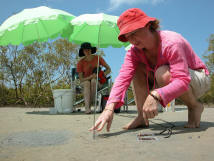
DISHONEST SIGNALLING
In animal communication it is generally true that the signals animals use convey accurate and honest information. Individuals of some species, however, produce deceptive signals that provide inaccurate information. This "cheating" may allow the signaller to attract mates or repel competitors when it would be incapable of doing so were it to signal honestly. Some fiddler crabs appear to signal deceptively. Fiddlers can autotomise their large claw and, through a series of moults, regenerate a new one. In most fiddler species, the regenerated claw is identical to the original. In some species, however, the regenerated claw is clearly different. It lacks teeth, has a smaller muscle mass and more delicate fingers. Males apparently quickly regenerate their claw to the same overall length as the original, but produce a cheaper version. This is less effective as a weapon but is lighter and therefore more easily waved. The regenerated claw appears to act as an effective visual bluff of fighting ability and may actually be preferred by mate searching females. I am presently investigating this apparent case of cheating.
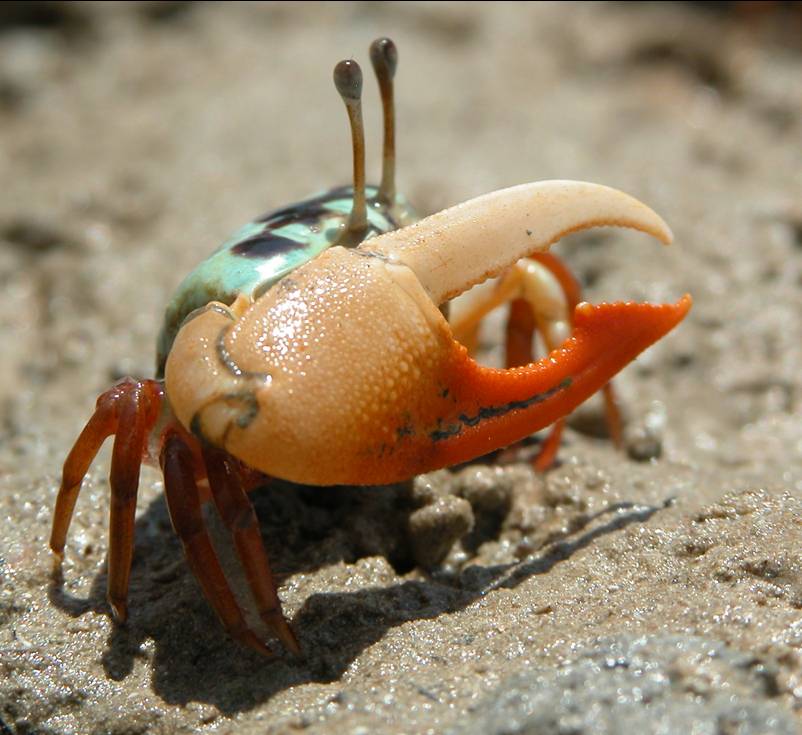
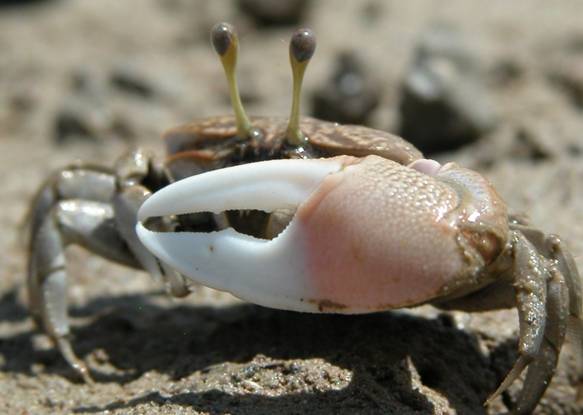
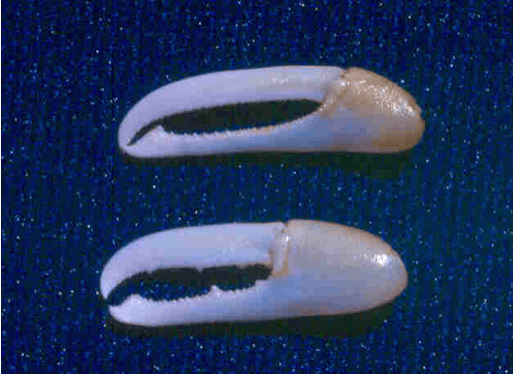
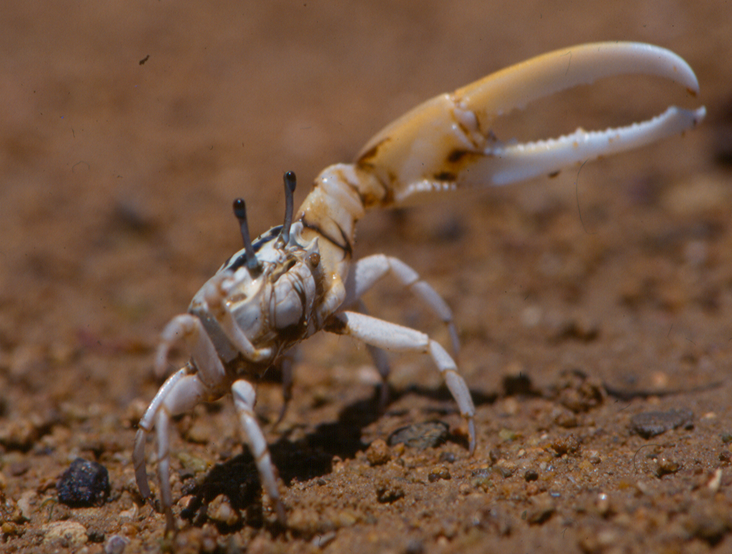
FIGHTING NEIGHBOURS AND STRANGERS
Male fiddlers use their enlarged claws in fights. Territory owners fight approaching strangers that try to steal their territories. They also fight neighbours to negotiate and demarcate territory boundaries. Strangers pose a greater threat than neighbours because losing a fight with a stranger means losing the entire territory whereas losing a fight with a neighbour results in a reduction in territory size. In other animals, fights with both strangers and neighbours are thought to be tests of strength with the stronger male most likely to win. Oddly, in fiddler crabs, this does not appear to be the case. Fights between neighbours do not appear to be settled by brute force. Instead, it appears that residents use aggression as a sort of punishment against encroaching neighbours. The fight itself inflicts time and energy costs on the neighbour so, by consistently engaging the neighbour in a fight each time it encroaches, residents may decrease the likelihood of the neighbour returning to the disputed area. If this is true, then fights between neighbours and those between strangers would be fundamentally different interactions. While strangers might fight to win, neighbours may not be trying to ‘beat’ the encroacher but rather to ‘nag’ it into respecting the border between them.
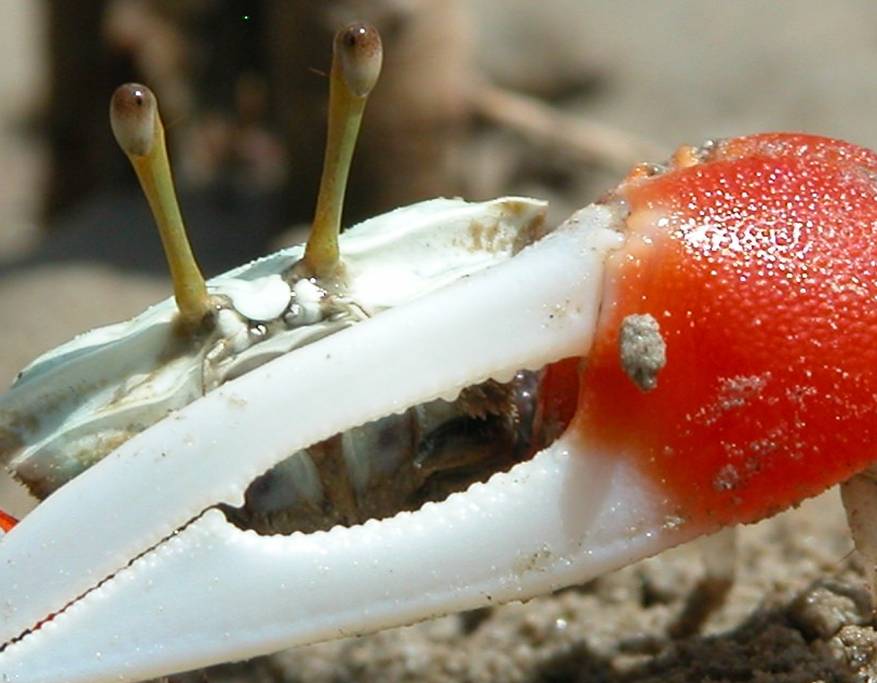
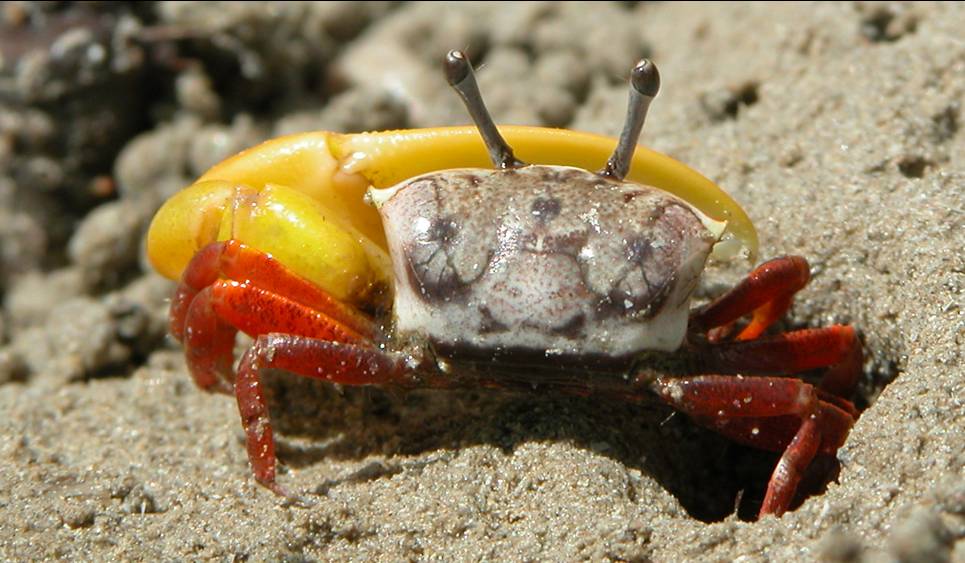
Fiddlers are amazing little animals. They are fun to watch, easy to study and they do really intersting things. It is strange that ALL biologists don't study them. They are much better than birds or mammals or fish or snakes.


